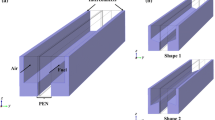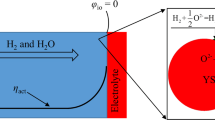Abstract
Two-dimensional (2D) model is used to analyze the thermo-mechanical behavior of anode-supported solid oxide fuel cell for a given thermal loading. In order to reduce the thermal stress generated during the preparation and operation of solid oxide fuel cell, the optimized anode functional layer is introduced into solid oxide fuel cell. In this work, based on the hierarchical model theory, the anode functional layer is divided into several sub-layers. The thickness and NiO volume fraction of each sub-layer gradient change and are controlled by non-linear thickness gradient exponent and non-linear composition gradient exponent, respectively. The optimization schemes are obtained to minimize the anode axial stress, the electrolyte compressive stress and the layer interface stress significantly, and the change trend of the anode axial stress over the entire temperature range is also analyzed. The research in this paper provides theoretical basis for optimizing the anode-supported solid oxide fuel cell.














Similar content being viewed by others
References
N.Q. Minh, T. Takahashi, Science and technology of ceramic fuel cells (Elsevier, Amsterdam, 1995)
S.C. Singhal, K. Kendall, High temperature solid oxide fuel cells: fundamentals, design and applications. Mater. Today 5(12), 55 (2002)
X. Chen, Z.Z. Lin, C. Yin, H. Tang, Y.C. Hu, X.J. Ning, Theoretical prediction of the growth and surface structure of platinum nanoparticles. Acta Phys. Sin. 61, 076801 (2012)
A. Selçuk, G. Merere, A. Atkinson, The influence of electrodes on the strength of planar zirconia solid oxide fuel cells. J. Mater. Sci. 36(5), 1173–1182 (2001)
A. Selimovic, M. Kemm, T. Torisson, M. Assadi, Steady state and transient thermal stress analysis in planar solid oxide fuel cells. J. Power Sources 145(2), 463–469 (2005)
D. Sarantaridis, R.A. Rudkin, A. Atkinson, Oxidation failure modes of anode-supported solid oxide fuel cells. J. Power Sources 180(2), 704–710 (2008)
F. Erdogan, B.H. Wu, Crack Problems in FGM layers under thermal stresses. J. Therm. Stress. 19(3), 237–265 (1996)
Y.D. Lee, F. Erdogan, Residual/thermal stresses in FGM and laminated thermal barrier coatings. Int. J. Fracture 69(2), 145–165 (1995)
S. Suresh, A. Mortensen, Fundamentals of functionally graded materials (IOM Communications Ltd., London, 1998)
Z.W. Wang, Q. Zhang, L.Z. Xia, J.T. Wu, P.Q. Liu, Stress analysis and parameter optimization of an FGM pressure vessel subjected to thermo-mechanical loadings. Procedia Eng. 130, 374–389 (2015)
T.Z. Jiang, Z.H. Wang, B.Y. Ren, J.S. Qiao, W. Sun, K.N. Sun, Compositionally continuously graded cathode layers of (Ba0.5Sr0.5) (Fe0.91Al0.09) O3−δ-Gd0.1Ce0.9O2 by wet powder spraying technique for solid oxide fuel cells. J. Power Sources 247, 858–864 (2014)
J. McCoppin, I. Barney, S. Mukhopadhyay, R. Miller, T. Reitz, D. Young, Compositional control of continuously graded anode functional layer. J. Power Sources 215, 160–163 (2012)
Z.H. Wang, N.Q. Zhang, J.S. Qiao, K.N. Sun, P. Xu, Improved SOFC performance with continuously graded anode functional layer. Electrochem. Commun. 11(6), 1120–1123 (2009)
Y.S. Wang, D. Gross, Analysis of a crack in a functionally gradient interface layer under static and dynamic loading. Key Eng. Mater. 183–187, 331–336 (2000)
Y.S. Wang, G.Y. Huang, D. Gross, On the mechanical modeling of functionally graded interracial zone with a griffith crack: anti-plane deformation. ASME J. Appl. Mech. 70(5), 676–680 (2003). doi:10.1115/1.1598476
G.Y. Huang, Y.S. Wang, S.W. Yu, A new multi-layered model for in-plane fracture analysis of functionally graded materials (FGMS). Chin. J. Theor. App. Mech. 37(1), 1–8 (2005)
A.C. Müller, D. Herbstritt, E.I. Tiffée, Development of a multilayer anode for solid oxide fuel cells. Solid State Ion 152–153, 537–542 (2002)
J.R. Kong, K.N. Sun, D.R. Zhou, N.Q. Zhang, J. Mu, J.S. Qiao, Ni-YSZ gradient anodes for anode-supported SOFCs. J. Power Sources 166(2), 337–342 (2007)
G. Anandakumar, N. Li, A. Verma, P. Singh, J.H. Kim, Thermal stress and probability of failure analyses of functionally graded solid oxide fuel cells. J. Power Sources 195(19), 6659–6670 (2010)
A. Nakajo, Z. Wuillemin, J.V. Herle, D. Favrat, Simulation of thermal stresses in anode-supported solid oxide fuel cell stacks. Part I: probability of failure of the cells. J. Power Sources 193(1), 203–215 (2009)
R. Clague, A.J. Marquis, N.P. Brandon, Finite element and analytical stress analysis of a solid oxide fuel cell. J. Power Sources 210(15), 224–232 (2012)
W.C. Jiang, Y. Luo, W.Y. Zhang, W. Woo, S.T. Tu, Effect of temperature fluctuation on creep and failure probability for planar solid oxide fuel cell. ASME J. Fuel Cell Sci. Tech. 12(5), 051004 (2015). doi:10.1115/1.4031697
J.H. Kim, G.H. Paulino, Isoparametric graded finite elements for nonhomogeneous isotropic and orthotropic materials. ASME J. Appl. Mech. 69(4), 502–514 (2002). doi:10.1115/1.1467094
T. Hirano, K. Wakashima, Mathematical modeling and design. MRS Bull. 20(1), 40–42 (1995)
A.E. Giannakopoulos, S. Suresh, M. Finot, M. Olsson, Elastoplastic analysis of thermal cycling: layered materials with compositional gradients. Acta Metall. Mater. 43(4), 1335–1354 (1995)
R.L. Williamson, B.H. Rabin, J.T. Drake, Finite element analysis of thermal residual stresses at graded ceramic-metal interfaces. Part I. Model description and geometrical effects. J. Appl. Phys. 74(2), 1310–1320 (1993)
S. Amada, Hierarchical functionally gradient structures of bamboo, barley, and corn. MRS Bull. 20(1), 35–36 (1995)
V. Teixeira, Numerical analysis of the influence of coating porosity and substrate elastic properties on the residual stresses in high temperature graded coatings. Surf. Coat. Tech. 146–147(2), 79–84 (2001)
C.L. Hsieh, W.H. Tuan, Elastic and thermal expansion behavior of two-phase composites. Mat. Sci. Eng. A Struct. 425(1–2), 349–360 (2006)
H. Yakabe, Y. Baba, T. Sakurai, Y. Yoshitaka, Evaluation of the residual stress for anode-supported SOFCs. J. Power Sources 135(1–2), 9–16 (2004)
P.F. Fan, G.J. Li, Y.K. Zeng, X.W. Zhang, Numerical study on thermal stresses of a planar solid oxide fuel cell. Int. J. Therm. Sci. 77, 1–10 (2014)
W. Fischer, J. Malzbender, G. Blass, R.W. Steinbrech, Residual stresses in planar solid oxide fuel cells. J. Power Sources 150, 73–77 (2005)
N. Bamba, Y.H. Choa, K. Niihara, Fabrication and mechanical properties of nanosized SiC particulate reinforced yttria stabilized zirconia composites. Nanostruct. Mater. 9(1–8), 497–500 (1997)
A. Atkinson, A. Selcuk, Mechanical behaviour of ceramic oxygen ion-conducting membranes. Solid State Ion. 134, 59–66 (2000)
J.R. Cho, D.Y. Ha, Volume fraction optimization for minimizing thermal stress in Ni-Al2O3 functionally graded materials. Mat. Sci. Eng. A Struct. 334(1–2), 147–155 (2002)
Acknowledgements
This work was supported by the National Natural Science Foundation of China [Grant numbers 11572253, 11372251).
Author information
Authors and Affiliations
Corresponding author
Rights and permissions
About this article
Cite this article
Xie, J., Hao, W. & Wang, F. Analysis of anode functional layer for minimizing thermal stress in solid oxide fuel cell. Appl. Phys. A 123, 656 (2017). https://doi.org/10.1007/s00339-017-1266-x
Received:
Accepted:
Published:
DOI: https://doi.org/10.1007/s00339-017-1266-x




